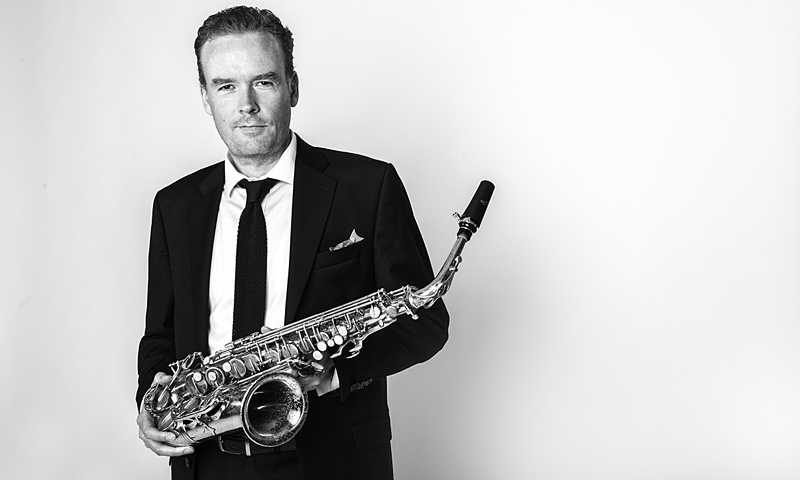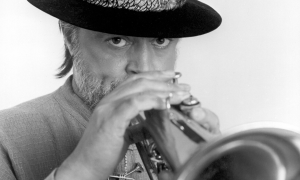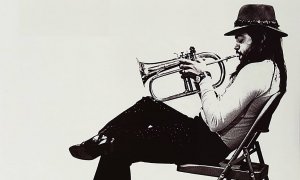Home » Jazz Articles » Catching Up With » Nick Hempton's Catch & Release
Nick Hempton's Catch & Release

My least favorite part of music is trying to sell it and talking about myself.
—Nick Hempton
It's a time of transition, then, but it's also one of experimentation. After releasing In Rainbows with Radiohead as a pay-what-you-like, DRM-free website download back in 2007, frontman Thom Yorke more recently partnered with file-sharing platform BitTorrent to release his second solo LP, Tomorrow's Modern Boxes, for an affordable $6. With her 2013 self-titled full-length, Beyoncé pioneered the "visual album," a complementary sight-and-sound experience, with iTunes as its vehicle. Using that portal's same expansive reach, the following year U2 dropped their new Songs of Innocence into personal music libraries around the world whether listeners wanted it or not. Also in 2014, prior to releasing Indie Cindy, their first album in nearly a quarter of a century, the Pixies stoked hype and maximized revenue by issuing the album's twelve tracks over three chronologically staggered multi-format EPs. They Might Be Giants resurrected Dial-a-Song and overhauled their fan club to offer tiered membership perks reminiscent of Kickstarter campaigns. And in the world of jazz, trumpeter Jeremy Pelt has been offering live, freely downloadable MP3s from his website for roughly a decade as a bonus to existing fans ("adding value" in the cold vocabulary of marketingspeak) and a means of introducing new listeners to his work. When tallying all the niche and indie acts along with the household names, the number of musicians who are performing variations on these themes to promote or distribute their work is considerable, and it's growing out of necessity.
Saxophonist Nick Hempton is among those spurred by the mother of invention. With three well-received albums—Nick Hempton Band (Triple-Distilled, 2009), The Business (Positone, 2011) and Odd Man Out (Positone, 2013)—under his belt as leader, the Australian expat opted for something more adventurous and, with any luck, more financially viable with his fourth. Titled Catch and Release , it's not so much a record as a project that aims to adapt the traditional jazz album to à la carte purchasing behavior and the staggered release format.
"It's simply making music and putting it into the marketplace the way people are already buying it," says Hempton. "In other forms of music, there are other revenue streams that aren't available in jazz. You can play huge arenas, sell merchandise. There's a lot more money to be had.
"Even at its best point, jazz never had a huge share of overall music sales. It's a very small market, and a big-band album, for example, is virtually unheard of today because it costs so much money to make. I want to get to the point where we're not cutting corners to make it happen."
Catch and Release officially kicked off last July with the title track, a sultry seven-minute, 24-bar swinger. It was recorded with drummer Dan Aran (who has performed on all of Hempton's albums as leader), pianist Jeremy Manasia and bassist Dave Baron. That was followed in September by the relaxed toe-tapping groove of "Hanging for Dear Life." Here Hempton leads once again on alto sax, and pianist Tadataka Unno steps in for Manasia.
Six weeks after "Hanging for Dear Life" appeared, Hempton issued "The Third Degree," which he describes as "Blue Note bossa" on account of its textural Art Blakey-like rolls and rim clicks that power a straight-ahead swing. Unlike the first two, it's a quintet performance. Hempton takes up the tenor sax for this one; guest musician Peter Bernstein features on guitar.
"I like the idea of keeping the regular band and then bringing in extra people," he says. "I'm thinking about doing this in future, and it's something you find on all the albums I've done. Having a track at a time allows a different way of looking at it, and on this one I wrote with Peter in mind. It allows me to write for a particular person and therefore a particular style of playing."
In early December, after a brief and unexpected delay, came "Montauk Mosey," the fourth and most recent track as of this writing. Hempton calls the duo ballad "a leisurely stroll with no urgent destination," and it features just him (back on alto) and Italian pianist Rossano Sportiello. Like all the tracks so far, it was recorded at Smalls Jazz Club in New York City's Greenwich Village, where Hempton has been performing for several years.
"Somebody once asked Charlie Parker which of his albums he should buy, and Bird said, 'Keep your money!' because the constraints of the studio always have a negative effect on the performance," says Hempton. "For people who've never recorded in a studio, you can't imagine how unpleasant that is. You can see the rest of your band, but you're all in these claustrophobic little booths and you can't hear anything. It's unnatural, and it's difficult to get real interplay.
"Here we're all next to each other, all looking at each other, in a familiar club setting, which makes for a much more natural way of creating music. So this experiment is a new thing but [it's] an old-fashioned way of recording."
At the end of the year-long experiment, the Catch and Release songs will likely be collected and sold as a conventional ten-track album—a digital download, to be sure, perhaps even a physical disc as well. The explanatory one-sheets Hempton has been distributing to the media alongside the individual tracks might also become liner notes. Like jazz itself, it's an exercise in improvisation. He has a broad framework in mind, but he's adapting on the fly in response to real-world conditions: the availability of certain musicians, for example, or the idiosyncrasies of listeners' buying habits. And he's finding, to his delight as well as his disappointment, that the practical and commercial parameters of the project are shaping and informing its artistic aspects.
"Jazz is very album-oriented and for good reason. The albums we've done in the past are like self-contained concerts. You pace it the way you'd pace a set," Hempton says. For the piecemeal approach of Catch and Release, however, he's had to develop thematic consistency retroactively.
"I'm not looking ahead when I write and record, but I am looking back. There has to be pacing [...] and knowing what we've already done presents its own challenges. But I'm enjoying those challenges, particularly with the writing. When I've written albums, I write half a tune here and half a tune there, and finish them all up just before the session. Now I have to make each one a whole composition within a certain period of time." Such a tight deadline—along with considerations for radio play, though Hempton admits to having second thoughts about that — also keeps the songs around the six-minute mark. "I'm doing this not because it's artistically preferable," he says, "but because this is the way a lot of people listen to music nowadays, and it might be what we have to do to sell music."
As a result, Catch and Release is more than a musical work in progress. It's been a learning experience in terms of the strengths and drawbacks of social media, and even the finer points of digital distribution. Hempton says he started out "naively" expecting people to buy the new songs directly from his band's Facebook page, where he regularly engages with the largest number of listeners.
"[W]hat was happening was that people would see the music player, click Play, then go buy it on iTunes. People do that because of the safety and convenience. I use the analogy of selling fish out of the back of your car: It might be cheaper, but there's something shady and disreputable about it. With iTunes, people trust it, but linking to it on Facebook, and getting people to see it, is proving to be challenging. Facebook is more of a drag than anything else. I wish people would send me a check and I could just send them an e-mail, but of course that's not practical." Broadly speaking, his experience with Amazon's digital download service has been less satisfactory than the "weird and mysterious process" that is iTunes, which takes thirty cents on the dollar as its cut.
"I like to use Twitter," for promotion and interaction, he says, "but it only reaches a small percentage of people, so it's not as useful. I don't know if anybody's found the ideal medium. There are so many billions of people out there, all using different things. I try. I'm learning and making new mistakes every day."
In an effort to be "transparent about the successes and failures of the project," Hempton has been posting anecdotes, musings, news and videos of the recording sessions to the Catch and Release blog. In late November, he supplemented his announcement of "Montauk Mosey" by linking to an in-depth New Yorker article on Spotify with characteristic commentary ("[I]t's difficult to read about these guys with their suites at the Plaza and their Ferraris," he wrote, "discussing selling art like it's frozen fish fingers."). Last September, when news broke of U2's (or rather, Apple's) unsolicited generosity, Hempton took the opportunity to reflect on the myriad costs of ostensibly free music.
"The point is not to cry poor," he explains, "but to open people's eyes to the way the culture is today. Free music has become quite prevalent, and it's hard not to think that that's okay when the option is there to get something for nothing. But now we have to make the effort to go and pay for it. Maybe some of this will help people to see that free music is hurting everybody in the long run, and it's hurting the culture as a whole."
Per Oscar Wilde's quip that the only thing worse than being talked about is not being talked about, Catch and Release, despite being "a pretty awful way of trying to sell music" by Hempton's own candid assessment, is having its intended effect. He says that new and existing listeners as well as other musicians are taking note of the experiment on account of its music, its novelty, and its emerging lessons on how to record and market music at a time when the industry is in flux.
"When I started out, I didn't have the scope of the project in mind. When you record and release an album, you usually do about two months of promotion, press interviews and that sort of thing, and then it's back to performing. With this, it's a full year of promotion. My least favorite part of music is trying to sell it and talking about myself.
"At shows when I mention it I feel like I'm harassing people," he says. Because it's not just asking the audience to perform a one-time transaction at the merch table after the gig; it's asking them for an ongoing investment of time, emotion and, yes, at ninety-nine cents a pop, even money. It's asking them to join him in the endeavor, if only at one remove, and to share in the fun and uncertainty. To follow his progress and his travails for twelve months. To gather songs like sweets dispensed at six-week intervals.
"That's the challenge of selling anything: finding the point of interest. To me, what I've got here is kind of new. I didn't take this model from somebody else; I came up with it myself. So it's really for myself as much as anyone else, and I'm just seeing what happens. I'm excited about trying to make it work. I have no idea how it will turn out."
With the bulk of the tracks yet to go, the outcome is still firmly in the hands of fate.
"Maybe," says Hempton, "we should have done this interview at the end."
Tags
Nick Hempton
Catching Up With
Eric J. Iannelli
Jeremy Pelt
Art Blakey
Peter Bernstein
Smalls Jazz Club
New York City
Charlie Parker
PREVIOUS / NEXT
Support All About Jazz
 All About Jazz has been a pillar of jazz since 1995, championing it as an art form and, more importantly, supporting the musicians who make it. Our enduring commitment has made "AAJ" one of the most culturally important websites of its kind, read by hundreds of thousands of fans, musicians and industry figures every month.
All About Jazz has been a pillar of jazz since 1995, championing it as an art form and, more importantly, supporting the musicians who make it. Our enduring commitment has made "AAJ" one of the most culturally important websites of its kind, read by hundreds of thousands of fans, musicians and industry figures every month.





















